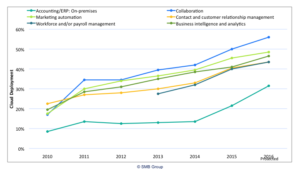“Big data” is a big buzzword in the IT industry—and for good reason. Basically, we’re doubling the amount of digital data that we create every two years, according to the EMC Digital Universe Study. Think about all of the different types of information that’s moved from physical to digital form just over the last several years.
Doctors have moved from paper charts to electronic medical records; merchants have moved from paper credit card imprinters to POS terminals to virtual terminals to mobile payment devices. Internet of Things (IoT) technology is equipping objects—from Fitbits to traffic sensors to seismographs—to record, report and receive data, and create entirely new digital data streams. And everyone is growing their digital footprint on myriad of social networks, and with the companies they do business with,
Organizations that can effectively harness and use this information can gain dramatic market advantages over those that don’t: SMB Group’s 2015 SMB Routes to Market Study shows that SMBs that have deployed analytics solutions are 14% more likely than peers to expect revenues to rise than peers that rely on spreadsheets for business analytics.
But let’s face it—most small and medium businesses (SMBs) don’t have dedicated data scientists on staff. Without this type of in-house expertise available, SMBs feel that moving from basic tools that analyze internal, transactional data to a more comprehensive analytics approach is out of reach.
However, a new generation of powerful, yet cost-effective cloud-based analytics solutions are emerging that can help level the analytics playing field for more SMBs.
Cloud Is the New Normal for SMBs
SMB adoption of cloud solutions has grown steadily over the last few years (Figure 1) to become part of the business fabric for most SMBs. In fact, SMB Group’s 2015 SMB Routes to Market Study reveals that SMB cloud deployments are poised to overtake on-premises deployments in the next year in areas such as collaboration, file sharing and marketing automation.
Figure 1: Trends In SMB Cloud Adoption
SMBs are moving to the cloud include because they view it as a more cost-effective, flexible and faster way to deploy IT solutions (Figure 2). Cloud computing take care of IT infrastructure, applications, and ongoing management and support, offering SMBs economies of both scale and skill.
Figure 2: Top Reasons Driving SMB Cloud Adoption
Analytics Meets the Cloud
In the analytics space, in which technology is advancing at warp speed, cloud analytics providers are building powerful, yet easy to use analytics solutions that few SMBs would have the resources or expertise to build on their own.
For instance, cloud analytics solutions often utilize database technologies that can deal with both structured and unstructured data, so that you can analyze different types data from both internal and external sources. They also use technologies to speed data processing, number crunching and analytics to deliver analysis more quickly to decision-makers.
Some vendors provide pre-packaged applications that integrate all of the components necessary for analytics solution, including connectors to business solutions; the data model; tools to extract, transform and load (ETL) data; a semantic layer; query and reporting capabilities; and predefined metrics, reports and dashboards.
In addition, cloud analytics providers build their infrastructures and services to support thousands of companies. This means they can offer customers on-demand scalability to adjust resources up or down as needed for peak decision-making times, such as during the holiday season for retailers.
Cloud analytics also gives everyone access to the same information in real-time. Instead of trying to reconcile data from different spreadsheets and applications, everyone is automatically on the same page in terms of data so they can reach consensus and make decisions more quickly.
As important, cloud analytics solutions are often designed for business users, offering capabilities such as:
- User-friendly interfaces, with guided discovery to make it easier to ask the questions that will lead to “aha” moments and insights.
- Visualization tools that turn rows of data into visuals that represent what the data says in intuitive ways.
- Natural language capabilities so users can easily query the data.
With these capabilities baked in, SMBs can start thinking about moving beyond descriptive analysis, which provides insight into the past to answer, “What has happened?” to more sophisticated analysis, including:
- Predictive analytics, which use statistical models and forecasts techniques to understand the future and to answer, “What could happen?” For instance, you could use predictive analytics to anticipate customer behavior and purchasing patterns, predict sales profitability trends, or forecast inventory demand.
- Prescriptive analytics, which use optimization and simulation algorithms to provide advice on possible actions to answer, “What should we do?” For example, Google’s self-driving car uses prescriptive analytics to decide whether and when the car should change lanes on highway by anticipating what might be coming in terms of traffic and other drivers.
SMB Preference for Cloud Analytics Is Growing
As in other solution areas, more SMBs are opting to analytics solutions in the cloud (Figure 3). SMB Group’s 2015 SMB Routes to Market Study shows among the SMBs that have purchased or upgraded an analytics solution in the past 24 months, 62% selected an on-premises solution, while 38% chose a cloud option. Looking ahead, however, just 40% of SMBs that are planning to purchase and/or upgrade analytics solutions are planning to buy an on-premises solution, while 42% are planning to use a cloud offering, and 18% have yet to decide.
Figure 3: SMBs’ Current and Planned Solution Deployment Methods for Business Intelligence/Analytics
Summary and Perspective
At a time when information is proliferating at an unprecedented rate, SMBs need to be able to easily access, understand, analyze, report and act on critical information. With the right tools, decision-makers can spot new opportunities, avoid mistakes and identify small problems before they mushroom into big ones.
Fortunately, more vendors are building powerful yet cost-effective cloud-based analytics solutions that are much easier to “layer” on top existing data than in the past. Designed for business users, these solutions offer user-friendly interfaces, guided discovery, visualization tools and natural language capabilities to help bring data to life.
While SMBs must still do their homework to determine which of the growing list of cloud analytics solutions will be the best fit for their businesses, the advantages of fact-based decision-making cannot be underestimated. The trend towards cloud analytics will likely strengthen in 2016, as more SMBs continue to opt for solutions that are easy to buy and use and can provide faster and better value to the business.
This post is sponsored by Dell.

